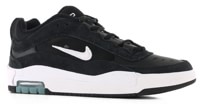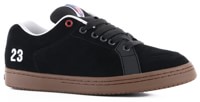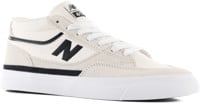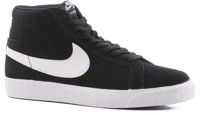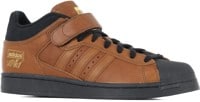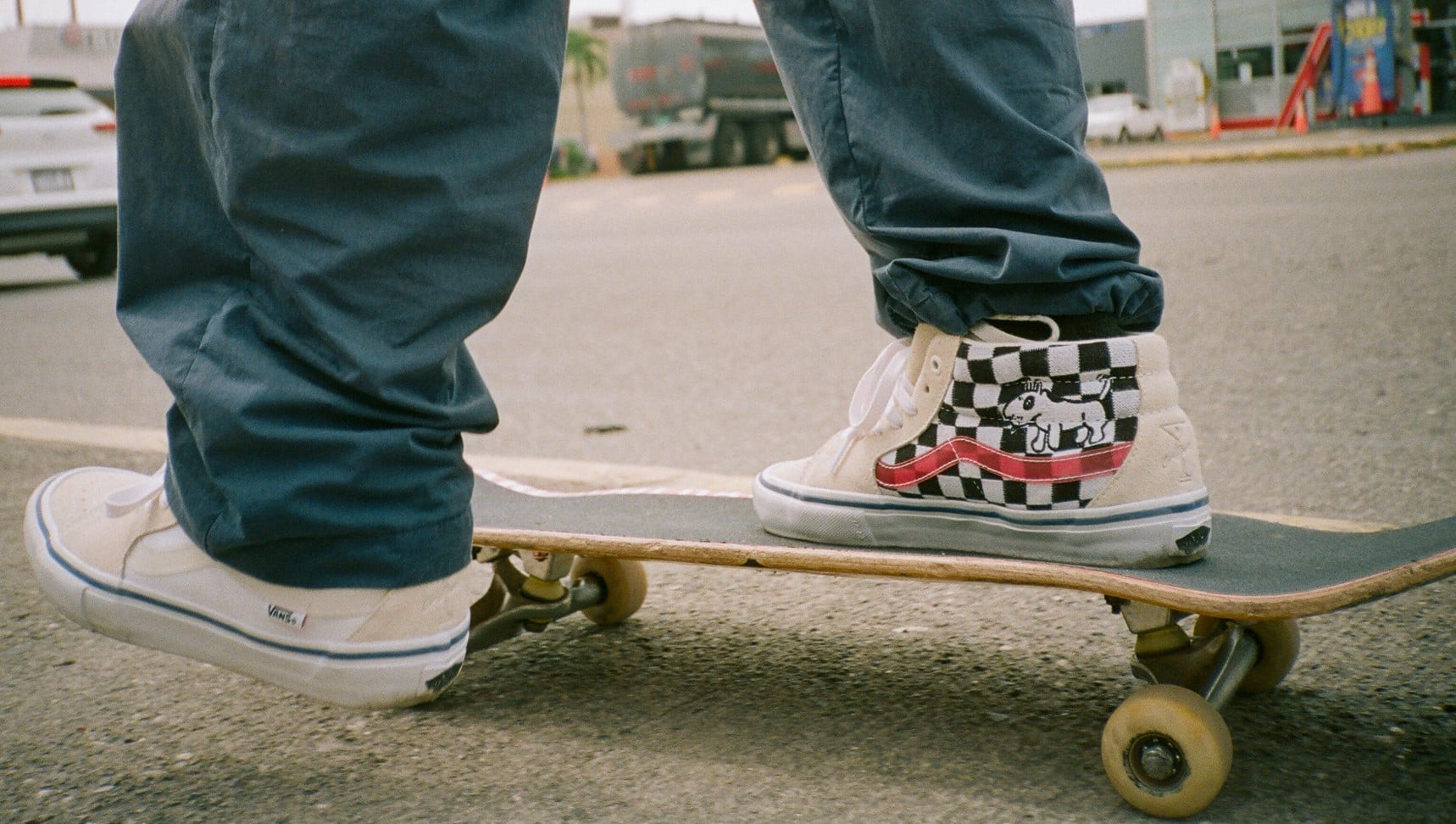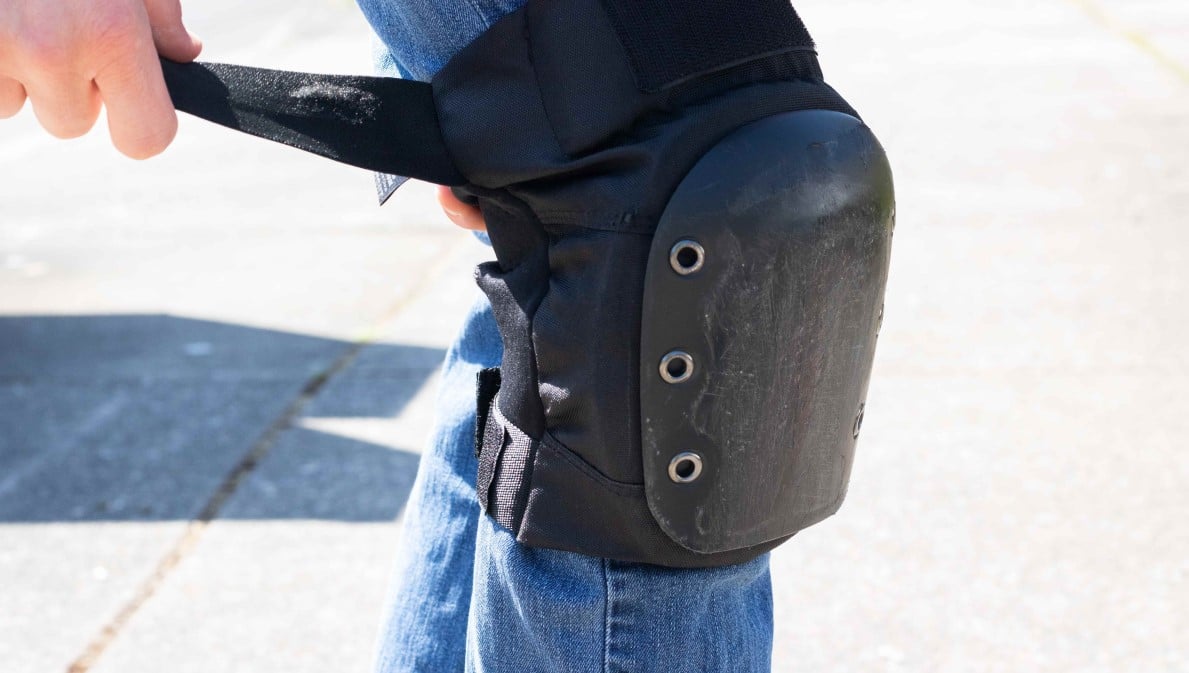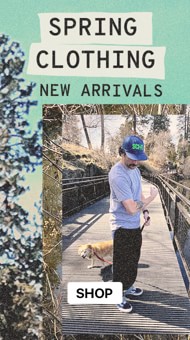How To Choose A Skateboard Shoe: A Beginners Guide To Skate Shoes
How to pick a skate shoe? This guide is your answer.
Skate shoes play a vital role in providing the necessary grip, durability, and protection required for riding a skateboard. We aim to equip you with everything you need to know to make an informed decision when choosing the best skateboarding shoes for your specific needs. From exploring the different types of shoes to highlighting the key features to look for, our comprehensive guide will ensure that you can focus on what truly matters— Skateboarding.
A Brief History Of The Skate Shoe
Skateboarding has come a long way since it was first invented, and so has the footwear designed for it. In this article, we'll take a look at skateboarding shoes from every angle, but we are going to start off by giving you a brief history lesson. The history of skate shoes dates back to the 1960s when the first skateboarders began experimenting with different footwear to enhance their time on board. During this era, the most popular skate shoes were Converse Chuck Taylors, which were basketball shoes that had thin soles and provided little protection or support for skateboarders.
As skateboarding grew in popularity, the need for specialized shoes designed for skateboarding increased. In the 1970s, the first skate shoe brands emerged, including Vans, and Airwalk which introduced shoes with a more durable sole and better grip. In the 1980s, skate shoes continued to evolve with the introduction of the high-top style and added ankle support. Today, skate shoes are prodcued by major shoe brands like adidas, Nike, and New Balance. All designing shoes with the latest technology and materials to provide skateboarders with the ultimate comfort, support, and durability. Now that you know the basics, Follow along below to learn what makes a skate shoe, a skate shoe.
Parts of a Skate Shoe
Skateboarding shoes consist of several parts, each of which serves a specific purpose. Here are the main components-
Sole: The sole is the bottom part of the shoe that makes contact with the skateboard. Typically made of durable rubber material, the sole provides grip and traction on the board. Skate shoes usually feature a flat and low-profile sole that enables the rider to feel more connected to the board. Some skate shoes may have a vulcanized sole, which is a more durable and flexible option achieved by baking the sole to the upper part of the shoe. Skate shoes may also come in a cupsole design, which features a single rubber outsole unit. This sturdy construction provides excellent shock absorption and durability, ensuring optimal protection against hard landings.
Upper: The upper part of a skate shoe refers to the area that covers the top and sides of the foot. It's commonly made of leather, suede, or canvas materials that provide flexibility, breathability, and durability. Skate shoe uppers can include design elements like perforations for ventilation and padding for protection and comfort.
Outsole: The outsole is the layer of the sole that contacts the ground and provides traction. It's usually made of a durable rubber material that can withstand the wear and tear of concrete, grip tape, and anything else you may step on.
Insole: The insole is the layer inside the shoe that provides cushioning and support for the foot. Skate shoes typically feature a removable insole, which enables riders to customize the level of cushioning and support based on their preferences and needs. Some skate shoes have a special type of insole known as an impact-absorbing insole, which reduces the shock and impact of skateboarding on the feet and joints.
Each part of a skate shoe is designed to serve a specific purpose. By understanding the function of each component, you can choose a skate shoe that best suits your needs as a skateboarder.
Skate Shoe Construction
In the world of skateboarding, two types of shoe constructions reign supreme: cupsole skate shoes and vulcanized shoes. These two styles cater to different needs and preferences, each with its own set of advantages. Cupsoles are the go-to choice for skateboarders seeking durability and shock absorption & vulcanized shoes, also known as "Vulc" shoes, are loved for their lightness, flexibility, and speedy break-in time. Both are excellent options, continue reading below to find out what type suits you.
| shoe type | pros | cons | best for | not recommended for |
|---|---|---|---|---|
| Cupsole |
|
|
|
|
| vulcanized |
|
|
|
|
CUPSOLE SHOES
Cupsole skate shoes are designed with durability and shock-absorption in mind, which makes them a popular choice for skateboarders. The shoe's construction features a single rubber outsole unit that is thicker and more rigid than the outsole found on a vulcanized skate shoe. The upper of a cupsole shoe is sewn and glued directly to the outsole, creating a strong and long-lasting bond between the two components. This construction method helps the shoe to withstand the stresses of skateboarding, making it a solid option for skaters who are tough on their gear.
One of the key benefits of cupsole skate shoes is their ability to absorb shock and protect the feet from hard landings. The thick rubber outsole provides extra cushioning compared to a vulcanized sole, which can prevent injuries and reduce foot fatigue. However, the extra cushioning may also mean that cupsole shoes may not provide as much flexibility or board feel as a vulcanized shoe right out of the box. Overall, cupsole skate shoes are ideal for skaters who like to jump down stairs, gaps, or other large obstacles, as the additional cushioning can help absorb the impact of hard landings. However, if you prefer board feel and flexibility, a vulcanized skate shoe may be a better choice for you.
VULCANIZED SHOES
Vulcanized shoes, also known as "Vulc" shoes, are a popular type of skateboarding shoe that are known for being light, flexible, and quick to break in. Unlike cupsole shoes, vulcanized shoes do not provide as much foot protection, but they offer a good board feel, making them a preferred choice for skaters who prioritize precision and control over impact protection.
The construction of vulcanized shoes is different from cupsole shoes. The upper of the shoe is connected to the outsole using a strip of rubber called foxing tape, which is wrapped around the perimeter of the shoe. The shoe is then baked in an oven, which melds the upper and outsole together into a single unit. This baking process softens the rubbers, which makes the shoe softer and more flexible. As a result, vulcanized shoes are thinner and lighter than cupsoles.
Vulcanized shoes are well-suited for a variety of skateboarding styles, including cruising around the streets, skating transition, and learning flip tricks on flat ground. They are also a popular choice for fashion-conscious skaters who appreciate their sleek, low-profile design. However, if you frequently skate big gaps or stairs, or if you are hard on your gear, you may prefer the extra cushioning and durability of a cupsole shoe.
Types Of Skate Shoes
Skateboarding shoes come in various styles and designs, each with their own unique benefits and drawbacks. High-top skate shoes feature a collar that extends above the ankle, providing extra support and protection during high-impact tricks. Mid-top skate shoes offer moderate ankle support while allowing more freedom of movement than high-tops. Low-top skate shoes have a lower collar and are ideal for skaters who prioritize flexibility and mobility. Slip-on skate shoes offer convenience and comfort with their laceless design, but may not provide the same level of support and stability as traditional lace-up shoes.
In the end, the choice between high-tops, mid-tops, low-tops, and slip-ons comes down to individual preference and skating style. Each shoe style has its benefits and drawbacks, so it's essential to consider the level of ankle support, flexibility, mobility, board feel, and convenience that you require to perform your best. Whether you prioritize ankle protection, speed, agility, or comfort, there is a skate shoe design that can meet your needs and we are here to provide
| SHOE TYPE | PROS | CONS |
|---|---|---|
| High-top |
|
|
| low-top |
|
|
| mid-top |
|
|
| slip-on |
|
|
High-Tops
High-top skate shoes feature a higher collar that extends above the ankle to provide extra support and protection during high-impact tricks and landings. This increased ankle support can help prevent injuries and provide a more secure fit, which is beneficial for skaters who need precise control over their board or just some extra support.
However, high-top skate shoes may feel more rigid and less flexible than low-top or mid-top shoes due to their added height and structure. The increased bulk and weight may also be a downside for skaters who prioritize speed and agility.
Ultimately, whether high-top skate shoes are a good choice for you depends on your skating style and personal preference. If you value ankle protection and stability, high tops may be a good option. However, if you prioritize flexibility and agility, a lower-cut shoe may be more suitable.



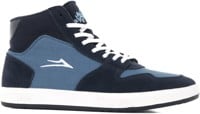

Low-Tops
Low-top skate shoes, on the other hand, are designed with a lower collar that typically sits below the ankle. This lower cut allows for greater mobility and flexibility, making them an excellent choice for skaters who prioritize a natural range of motion. The lack of added height and structure can also make low-tops feel lighter and less bulky, which can be beneficial for skaters who want to maximize their speed and agility.
However, since low-top skate shoes offer less ankle support and protection compared to high-tops, they may not be the best choice for skaters who require extra stability or are prone to ankle injuries. Ultimately, the decision between high-tops and low-tops comes down to personal preference and skating style.
Mid-Tops
Mid-top skate shoes feature a collar that sits above the ankle but below the calf muscle, providing a balance between the ankle support of high-top shoes and the mobility of low-top shoes. This design offers moderate ankle support while allowing more freedom of movement than high-tops.
Like other skate shoes, mid-tops come in a variety of materials, including canvas, leather, suede, and synthetic materials. The choice of material can affect the shoe's durability, weight, and breathability. Additionally, the type of sole can vary between brands, with some featuring vulcanized soles for better board feel, while others may have cupsoles for added support and cushioning.
The choice of a mid-top skate shoe depends on the skater's personal preference and needs. They may be a good choice for those who want a balance between ankle support and freedom of movement but may not provide enough support for those who require extra protection for their ankles.



Slip-Ons
Slip-on skate shoes are a popular option among skaters who value convenience and comfort. These shoes are designed without laces, making them easy to put on and take off quickly. Slip-on shoes often have elastic panels or gussets that allow the shoe to stretch and fit snugly around the foot. This can provide a comfortable, sock-like fit that is ideal for skaters who prioritize board feel and control.
While slip-on shoes can be a great option for some skaters, they may not be the best choice for everyone. Without laces, slip-on shoes may not provide the same level of support or stability as traditional lace-up shoes. Additionally, some skaters may find that slip-on shoes can slip off or feel loose during high-impact tricks or. Whether slip-on skate shoes are a good choice for you depends on your skating style and personal preference. If you value convenience and comfort, slip-on shoes may be a great option. However, if you prioritize support and stability, you may prefer a lace-up shoe.




Skate Shoe Materials
When it comes to skateboarding, choosing the right shoe material is essential for both performance and longevity. Different materials offer distinct benefits and drawbacks that cater to various skateboarding styles and preferences. Canvas, a lightweight and breathable material, has been a favorite since the 1970s, although it tends to wear down quickly when subjected to rough grip tape. Leather, on the other hand, is incredibly durable and can withstand extensive wear and tear from tricks, but its lack of breathability can lead to sweaty feet. Suede strikes a balance between canvas and leather, combining durability with a thinner and more breathable construction. However, prolonged use can result in soggy feet. Lastly, textile is a popular choice for newer "tech" skate shoes, providing a lightweight, breathable, and durable option often combined with suede or other protective materials. Understanding the characteristics of each material allows skaters to make informed decisions when selecting their ideal skate shoe. Follow along below and we will explain more.
| shoe type | pros | cons | best for | not recommended for |
|---|---|---|---|---|
| canvas |
|
|
|
|
| Leather |
|
|
|
|
| suede |
|
|
|
|
| textile |
|
|
|
|
Canvas
Canvas has been a popular material for skate shoes since the 70s due to its lightweight and breathable nature. However, the canvas is less durable than other materials and can wear down quickly when slid across coarse grip tape. Canvas shoes are best suited for skaters who prefer cruising around and carving on transitions, rather than doing a lot of flip tricks.







Leather
Leather is an ultra-durable and abrasion-resistant material, making it an excellent choice for skateboarders. It can withstand a lot of wear and tear from tricks without much damage to the flick area of the shoes. However, leather shoes offer little breathability for feet, causing them to get hot and sweaty quickly.









Suede
Suede is a happy medium between canvas and leather, combining the best of both worlds. It is highly durable and has excellent abrasion resistance, while also being thinner and more breathable than leather. However, after a long session, feet can begin to feel soggy in most suede shoes.
Textile
Textile is a lightweight, breathable, and durable material that is commonly used in newer, more "tech" skateboarding shoes. Most shoes that use textiles also have suede or other materials to cover areas that are likely to see the most damage. Many companies' cupsole shoes use textile uppers to reduce weight while maximizing padding and bulk.






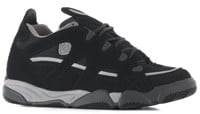









Other Features
Skateboarders know that they need a shoe that will last. That is why many companies have begun to invest in new ways to strengthen shoes where necessary. Skaters also need shoes that keep them comfortable while skating for hours on end. Sometimes the smallest features make the biggest impact on shoes and can make or break your skateboarding experience.
Heel Protection
One injury that is sure to end a session early are heel bruises. This is why many shoe manufacturers have created different heel-saving technologies to add to their shoes. Nike and Converse feature Zoom Air Bag heels in their insoles. These are a low-profile, yet highly effective to protect your heels. Other companies have used EVA foam within their shoes to create a thicker barrier between the ground and your heel. One example is Adidas’ ADIPRENE®, but many companies use similar technology.

Toe Caps
Companies, such as Vans, Converse and Adidas, have created what are known as toe caps. These are rubber strips that protect high-wear areas of their shoes. Some shoes feature external toe caps, while others utilize the rubber below the uppers. This way, holes that develop in the upper material expose rubber instead of your foot, keeping you protected and giving your shoes a longer lifespan.

Gusset Tongues
Nothing is more annoying than a shoe tongue that won’t stay centered. When your shoe’s tongue slides to one side or the other, it can cause pressure points. This is why some skateboarding shoes feature elastic gussets that connect the tongue and the midsole, giving you a snug fit and keeping your tongue in place.

Double-Wrapped Foxing Tape
Foxing tape is the rubber strip that borders the bottom of the shoe. Many skate shoe manufacturers bulk this feature up by adding a second layer of foxing tape to reinforce that part of the shoe. This way areas such as the toe and heel will last longer.

Keep Learning
Still Have Questions?
If you still need more information, rest assured that we have the resources to help you out. Our customer service team is highly knowledgeable and can answer any questions you may have about skateboard equipment. You can easily reach out to them by phone or message.
Additionally, if you are in Portland, Eugene, Seattle or Bend, feel free to visit one of our local shops and speak to one of our friendly and helpful retail employees. They'll be more than happy to assist you and provide any information or guidance you need. Don't hesitate to reach out to us - we're here to help!
Customer Service:
Call us toll-free at 888.450.5060
Text us at: 888.450.5060
Monday - Friday, 8 a.m. - 6 p.m. Pacific Time
Saturday - Sunday, 9 a.m. - 5 p.m. Pacific Time


